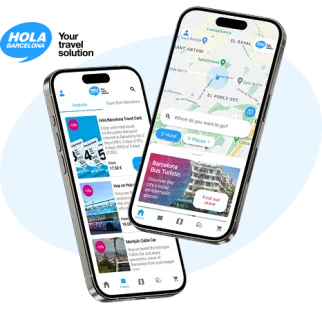Royal Palace of Pedralbes and Gardens
Architecture, sculpture and gardens for royalty
The period’s best architects, sculptors and landscapers transformed a country house and its farmland into a majestic royal palace surrounded by gardens. The Royal Palace of Pedralbes combines both the French and English landscaping traditions in impressive gardens surrounding a Noucentista palace.

Barcelona Bus Turístic, on the Hola Barcelona app
Your app for visiting the city with the Barcelona Bus Turístic: routes, stops and the most iconic places. A comfortable way to carry your tickets too!
Why visit the Royal Palace of Pedralbes?
The Royal Palace of Pedralbes was a 17th-century country house that Count Eusebi Güell, Gaudí’s patron, purchased in 1862 with its neighbouring plot to create the Finca Güell, an estate covering a surface area of some 30,000 m².
The main building, built by Joan Martorell i Montells, was a palace with a Caribbean air, accompanied by a neo-Gothic chapel. In 1887, Antoni Gaudí received the commission to renovate this construction and converted it into a Mudejar-influenced building accessed by an enormous door decorated with an iron dragon. The Modernista genius also constructed the exterior walls, a parabolic pergola covered with vines and the Hercules Fountain, a stone and wrought iron composition formed by a curved bench, a pedestal and an iron dragon head as the spout, on top of which there is a modern bust of the mythological hero Hercules.
Following a fire at the residence used by the king and queen when they were visiting Barcelona, Eusebi Güell ceded ownership of the house and part of the gardens to the Crown in 1918 in appreciation of his appointment to the nobility. The subsequent renovation work consisted of the construction of a new palace by the architects Eusebi Bona and Francesc Nebot. The resulting palace is formed by a four-storey central structure with a chapel at the rear and two three-storey lateral wings that curve onto the main facade. The exterior facade is in the Noucentista style with Tuscan column porches, Roman arch openings with interspersed medallions and urns crowning the construction. The interior features a wide variety of styles, both in terms of decoration and furniture, ranging from Louis XIV to more contemporary styles. Inside you can visit what was the bedroom of King Alfonso XIII and the waiting room and bedroom of his wife Victoria Eugenie of Battenberg.
One of the outstanding features of the site is its gardens, which were designed by Nicolau Maria Rubió i Tudurí, who subsequently designed Turó Park. It is a large space dominated by an elegant pond flanked by granite sand paths that criss-cross the entire park. Rubió i Tudurí respected the hundred-year-old trees that were on the land, such as a large grove of Himalayan cedars, but the garden was also home to large Atlas cedars, Japanese cedars and incense cedars, in addition to rows of lime trees providing shade for the main paths. The gardens are also full of conifers and shrubs such as laurels and European boxes. The queen amongst the flowers is undoubtedly bougainvillea, which paints the gardens an intense fuchsia.
Currently, Palauet Albéniz is the official residence of the royal family when they visit Barcelona. The Royal Palace of Pedralbes is now the seat of the Secretariat-General of the Union for the Mediterranean, and every summer its gardens play host to a music festival.
How do you get to the Royal Palace of Pedralbes?
Hop off at the Palau Reial – Pavellons Güell stop on the Blue Route of Barcelona Bus Turístic.
For the most curious of you
- Did you know? The site of Antoni Gaudí’s Hercules Fountain was located in the middle of a bamboo forest that hid it so completely that it had gone unnoticed until it was rediscovered by the municipal architect Ignasi Serra i Goday in 1983.
- Local’s tip: After visiting the Royal Palace of Pedralbes you should also spend some time at Cervantes Park, which is home to an impressive rose garden. In the blooming season you can see as many as 150,000 roses!
- A must: To sample the refinement of gardens designed in both the French and English styles.











